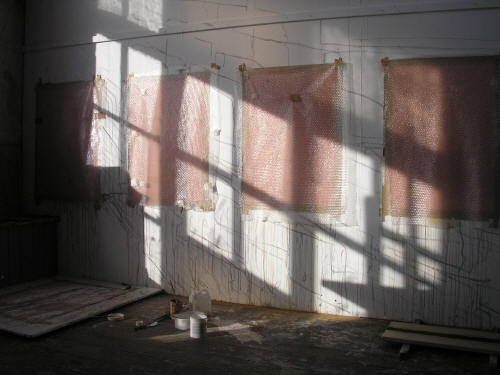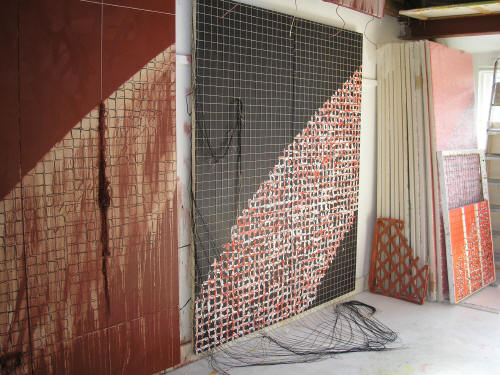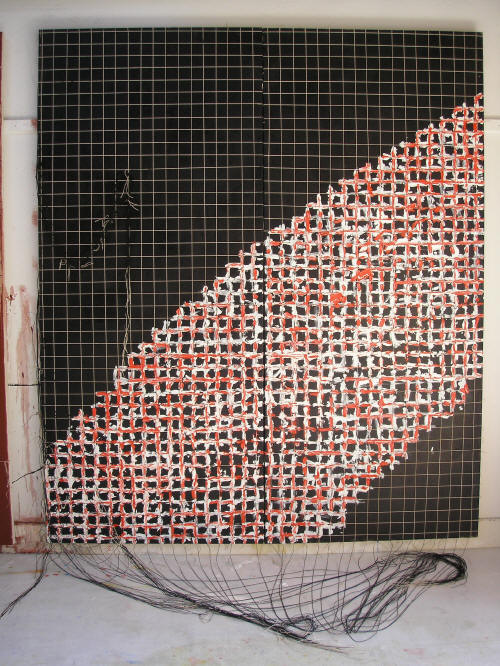|
|
| home | features | exhibitions | interviews | profiles | webprojects | gazetteer | links | archive | forum |
|
Prima Vista – Black, Red And White 12 July 2005 Clare Wardman
As one of Truro Cathedral's invited artists, Clare Wardman’s painting titled ‘Prima Vista Black, Red And White 12 July 2005 14:16 – 17:32’ has been selected for display in St Mary’s aisle from 5 Jan – 9 Feb 2009. The text from ‘Ecclesiastes 3’ which describes different experiences of time forms the basis of this programme of events.
For centuries, painters, poets, writers and composers have been inspired by the subject matter of light and dark. As a painter, light became the starting point for a new body of work, and in 2003 I started to track the movement of natural light and shadow in my studio in St Ives Cornwall. As paintings and ideas developed my thoughts have turned to questions about the secular nature of the subject matter and its symbiotic relationship with religion: ‘Festivals Of Light’ for example the Hindu festival of ‘Diwali’, for Muslims ‘Charakar’, in the Jewish Calendar ‘Hanukkah’ and the importance of light and its specific meanings for Christians with the celebration of ‘Epithany’ and ‘Candlemass’.
Earlier this year, The Revd. Canon Philip Lambert from Truro Cathedral visited my studio at Porthmeor Studios in St Ives and in consultation, the work titled ‘Prima Vista Black Red and White 12 July 2005’ was selected to commence the start of Truro Cathedral’s Arts Programme 2009. The text taken from ‘Ecclesiastes 3’ forms the basis of this programme of events and the painting accompanies verses 1-14 in the scripture which relates to ‘experiences within time’. In the painting, time is experienced as duration. From the moment a diagonal shaft of afternoon sunlight in the shape of a diamond – the aperture of the skylight – moved across and through the physical pictorial space took approximately 316 minutes from 14:16 to 17:32 - a focus of energy, warmth and brightness which could have gone unnoticed in the working environment, something felt as well as observed. Light and shadow on their cyclical journey through our lives however long or short they may be.
In the paintings of Caravaggio the dramatic use of light and shadow for example in the work titled ‘The Calling Of Saint Matthew’ depicts the moment where Matthew’s awakening to devote his life to God is revealed. In Truro Cathedral, the contemporary work by Scottish artist Craigie Aitchison RA titled ‘The Calvary’ forms part of St Margaret’s Altar in St Mary’s Isle. The work consists of four panels showing a landscape illuminated by a mystical light. The concept of time in these pictures can perhaps be experienced by the viewer in many ways. The inclusion of a bright star for example, recalls Christ’s birth observed by the Magi.
‘Prima Vista’, or first view, relates to landscape and each mark on the surface of the canvas making up the pictorial void is a fluid, spatial statement of the celestial movement of our universe. The Cornish Painter Peter Lanyon (1918-1964) noted a ‘revelation of time’ in his work. He was concerned with being immersed in the process ‘the body in motion’. My involvement with the subject matter is neither passive nor static but an active, flowing engagement towards perception and enlightenment in painting. Importantly, this includes light and shadow. The composer Sir Michael Tippet once commented ‘I must know my shadow and my light so that at last I shall be whole’.
The painting is
part of an on going series – ‘Light Tracking’ – concerning the movement*
(see footnote) of light and shadow not only
in the studio context but also its application in landscape and in 2007
I gained invaluable experience when I carried out a research project in
the Sculpture Garden of The Barbara Hepworth Museum, St Ives.
*The idea of movement and time in the painting is also linked to photography, in particular the French physiologist Jules-Etienne Marey (1830-1904) and his invention called the Chrono-photograph. This early device, the new technology of the day, produced a series of images showing various objects such as birds and the human figure – running, jumping, fencing, boxing, etc. The results from these subtle and beautiful recordings and experiments, for example, ‘Gull In Flight’ 1887 and ‘Chronograph Of A Man Walking’ 1887 which detailed an object’s movement in space, played an important role in the work of 20th Century artists including Marcel Duchamp (1887-1968) and his painting ‘Nude Descending A Staircase’ No.2 1912 Oil On Canvas, Edgar Degas (1834-1917) ‘Annie G. In Canter’ 1887 Charcoal On Paper and Umberto Boccioni (1882-1916) ‘States Of Mind 1 Farewells’ 1911 Oil On Canvas and his ‘Unique Forms Of Continuity In Space’ 1913 Bronze Sculpture).
Clare Wardman came to St Ives in 1999 and is a Porthmeor Studios Artist. 16/1/09 |
|
|




